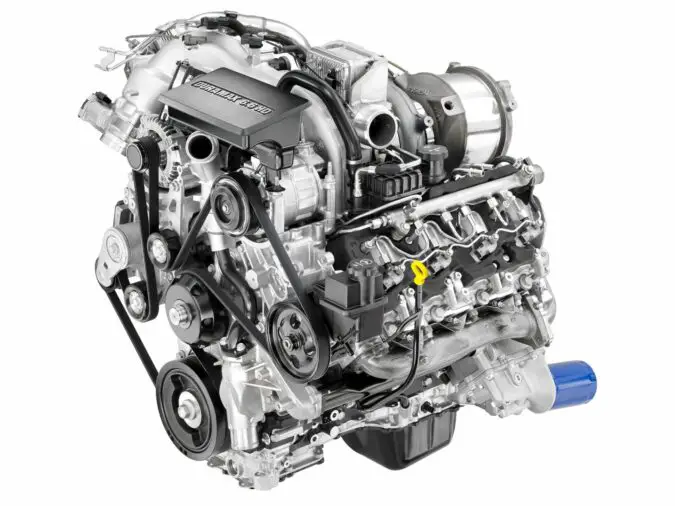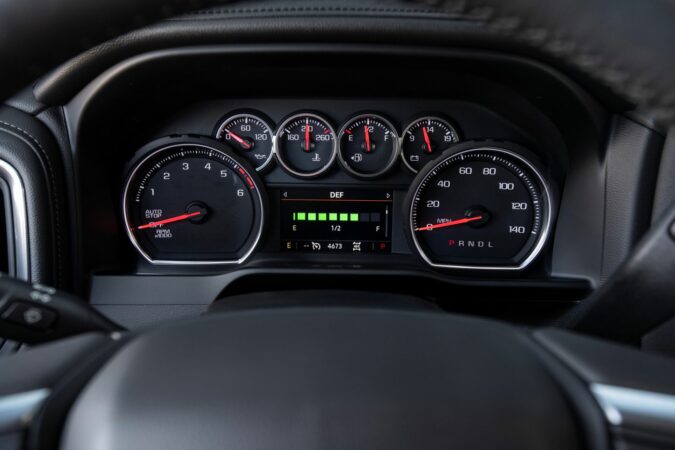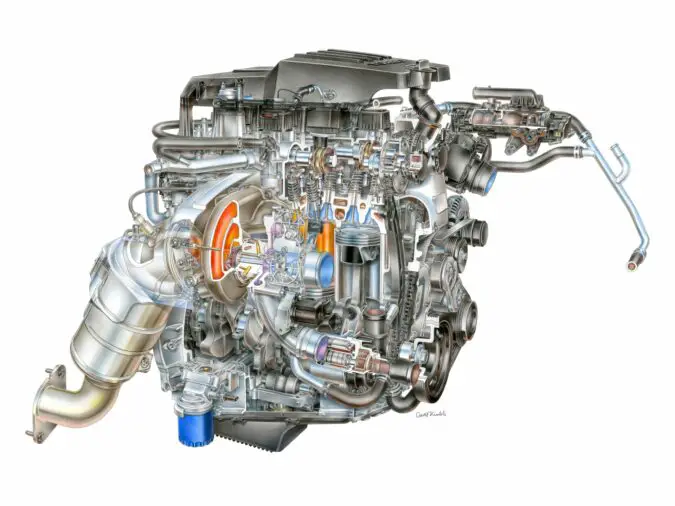The Chevrolet Silverado is one of the best-selling full-sized pickup trucks in the United States. For over two decades, this truck has built a reputation for being one of the most practical and capable vehicles out on the road. But, even the most reliable vehicles have their flaws, and it remains the same for this truck as well. The P0101 Chevy Silverado error code is one such common issue, and today we’ll tell you all about it.
In recent times, the OBD2 scanner has become a vital tool in vehicle maintenance and fault diagnosis. This singular equipment has cut down the labor costs that would otherwise be spent on trying to find hidden errors.
With the use of the error code displayed by the scanner, mechanics can pinpoint the specific part behind the problem, and apply the necessary fixes. This practice saves owners both time and money.
So, with that out of the way, let’s proceed with our discussion on this Chevy Silverado fault code. If you are the proud owner of one of these pickup trucks, you should stick around until the end.
OBD2 Scanner
You should have a clear idea of what an OBD2 scanner is before going on to discuss the P0101 Chevy Silverado code. OBD stands for Onboard Diagnostics, and it was created by the California Air Resource Management Board (CARB).
The history of this system dates back to the 1990s. In fact, this system has been present in every vehicle made since 1996.
This device acts as an interface between your vehicle and your computer or phone, letting you identify fault codes from your vehicle. The port utilized by this device is universal, meaning that it can be used for compact cars all the way to multi-million dollar luxury cars.
You can identify several basic components of the OBD system. They are,
- Sensors
- ECU
- DTC
- MIL
- DLC
OBD2 Components #1 – Sensors
Almost all vehicles from the modern era have an array of sensors covering each and every critical system. This includes the engine, transmission, chassis, and even the wheels. Codes from these sensors are periodically sent to the ECU. There, the signals are read and processed.
OBD2 Components #2 – ECU
The ECU is one of the most integral parts of the OBD scanning system. It collects all the data sent from the sensors mentioned above and uses that information to take various actions. If the car ECU detects any anomalies, the respective warning light will be displayed on the dashboard.
OBD2 Components #3 – DTC
Diagnostic Trouble Codes (DTC) consist of a series of letters and numbers. This is where the ECU saves information about problems that fall outside of its normal operational range. Although most of these codes are standardized across all automotive makers, there may be manufacturer-specific codes as well.
When a DTC code is saved in the ECU, the warning lights on the dashboard relative to that issue will illuminate as well. By linking an OBD reader to the vehicle, mechanics can pull these codes and read them in order to apply the necessary fixes.
OBD2 Components #4 – MIL
Another important part of the OBD system is the Malfunction Indicator Lights (MIL). However, some people refer to them as dashboard warning lights as well. An illuminated warning light indicates that there is a minor problem with the vehicle. But, if the light keeps flashing, it indicates a major issue with the vehicle.
OBD2 Components #5 – DLC
The DLC, or the Diagnostic Link Connector, is the final component of the OBD system we’ll be taking a look at today. This component acts as the point of access for the OBD system into the vehicle. In other words, all the DTC codes collected by the ECU can be accessed by external parties through the DLC.
On most passenger vehicles, the DLC is located on the driver’s side, underneath the dashboard.
However, it might be located elsewhere on some commercial vehicles. This is a type 2 connector, which means that any scan tool with a type 2 cable can be connected to this system.
As we already mentioned, the OBD system has many important uses. Some of the most common applications of this system include,
- Emissions Testing
- Monitoring Driver Behavior
- As Additional Instrumentation
- Gather Telematics
Uses Of OBD #1 – Emissions Testing
As mentioned above, the OBD system can be used to gather diagnostic information about various aspects of a vehicle. This includes the emissions system as well. With the use of the OBD system, inspectors can check the emissions compliancy of a vehicle simply through the use of a scan tool.
This method of emissions diagnosis is common in the United States. Moreover, it is important to add that diagnosing emissions issues in this manner is both efficient and doesn’t cause any environmental pollution.
Uses Of OBD #2 – Monitoring Driver Behavior
Driver behavior monitoring is another use of the OBD system. Some companies tend to install data loggers that connect through the OBD port to their feet or delivery vehicles.
The main intention behind this practice is to keep an eye on their employees. In addition to allowing organizations to track their drivers, this method allows them to reduce their liability in case of traffic accidents or violations.
However, employee tracking is not the only use of data loggers. Auto insurance companies also use these devices to identify whether their drivers are exhibiting safe driving practices. Not only that, but they offer reduced premiums for drivers who use these devices which encourages more people to use them.
Uses Of OBD #3 – As Additional Instrumentation
The OBD system is a great source of additional vehicle metrics that are otherwise not displayed in the vehicle’s standard configuration. This feature is mostly used by professional drivers and diehard \enthusiasts.
By connecting different devices to the OBD system, drivers can get additional information about different aspects of their vehicles. These can either be displayed through custom dials in the interior or broadcast directly to the driver’s mobile device.
Uses Of OBD #4 – Gather Telematics
The OBD system is used by commercial vehicle companies to gather data on their vehicle fleet. Some aspects on which OBD data gathering is used include monitoring fuel efficiency, keeping an eye on driver behavior, remote diagnostics as well as vehicle fleet tracking.
Now that you have a good idea of what OBD diagnosis is, let’s move on t discussing the P0101 Chevy Silverado error code in more detail.
P0101
The P0101 Chevy Silverado code is one of the most common DTC codes associated with this pickup truck. It is indicative of a mass air flow sensor (MAF) system performance problem.
Specifically, this issue arises when the airflow measurement from the MAF sensor does not correlate with the data sent from other sensors. These include the TPS signal from the throttle plate angle measurements and the CKP sensor’s RPM information.
The fuel injection computer triggers the P0101 Chevy Silverado code when the aforementioned data from your pickup truck does not correlate for at least 12 seconds with the engine turned on.
Not only that, but the check engine light will turn on during this period as well. Apart from the Chevrolet Silverado, this issue is also present in GMC Sierra models equipped with the 4.8-liter. 5.3-liter and the 6.0-liter V8 engines as well.
There are several major symptoms of the P0101 issue that can help you identify it beforehand. These include,
- Check Engine Light Turning On
- Rough Idling
- Frequent Stalls
- Black Smoke Coming From The Tail Pipe
- Issues With Startup
- Slow Acceleration
- Lack Of Engine Power
We mentioned the mass air flow sensor several times so far in this article. Before proceeding further we thought of introducing this component to you in more detail.
Mass Air Flow Sensor Symptoms
The mass air flow sensor is an integral part of a vehicle’s electronic fuel injection system. Typically, this component is located between the intake manifold and the air filter. Furthermore, it is important to mention that some cars have the intake air temperature (IAT) sensor built inside the MAF sensor as well.
The main function of the mass air flow sensor is to measure the amount of air flowing into the engine. This data is crucial, as it is used to calculate the amount of fuel required to achieve the best air-to-fuel ratio. Ideally, this ratio should be 14.7:1. Yet, it is not uncommon for this ratio to vary between different car makes and models.
Additionally, the air-to-fuel ratio changes depending on driver inputs as well. For example, when you are cruising around town, the mixture can get as low as 22:1.
In contrast, it can get as high as 12:1 under acceleration. Failure of the mass air flow sensor severely affects the air-fuel ratio and causes problems like the P0101 Chevy Silverado error code.
Although there are several types of mass air flow sensors, most modern cars use what is known as a hot-wire system. Here, a small electrically heated wire is observed by a temperature sensor nearby. As the engine is idling, the current flowing through the wire is also small, meaning that it takes only a small amount of energy to keep it warm.
Some of the main symptoms of a faulty mass air flow sensor are,
- Jerking Engine
- Black Smoke
- Misfires
- Check Engine Light
- Bad Fuel Economy
- Lean Idling
Now, let us take a look at each of these issues in more specific detail.
Mass Air Flow Sensor Symptoms #1 – Jerking Engine
If the engine of your Silverado is producing abnormal jolts or if you notice it is hesitating to produce power, that might be your first indication of a mass air flow sensor problem. The situations where you’ll notice these problems the most are when traveling along at regular speeds or under acceleration up on a highway on-ramp.
In addition to being uncomfortable for the occupants, driving a car in this manner is highly dangerous as well. So, if your pickup truck is suffering from a jerking engine, you should take it to a mechanic as soon as possible. Therefore, be wary of those instances where your car jerks when accelerating.
Mass Air Flow Sensor Symptoms #2 – Black Smoke
It can be scary noticing that thick black smoke is coming out of the exhaust. This is an obvious sign that something is wrong with your engine, and it can be caused due to an array of causes.
Damage to the mass air flow sensor is one such cause. This causes the ECU to calculate and inject an improper fuel amount into the combustion chamber, resulting in black smoke coming out of the exhaust.
Mass Air Flow Sensor Symptoms #3 – Misfires
As the mass air flow sensor is essential in obtaining the correct and best air-fuel ratio, it is no wonder that its failure causes several engine issues. If the signals coming from the MAF are inaccurate, it will cause the powertrain control module (PCM) to get confused about the amount of air entering the system.
As you might already know, the PCM is responsible for managing several systems of the car. This includes the engine and transmission among others.
When the PCM (powertrain control module) takes a wrong decision about the amount of fuel to inject, it may cause the car to start running rich, or for the engine to be running lean.
When an engine is running too rich, too much fuel is injected into the combustion chamber. Similarly, an engine that is running too lean will inject too little fuel. However, both these situations result in the same outcomes, including rough (such as the car sputtering when it’s idle) running as well as misfires.
Mass Air Flow Sensor Symptoms #4 – Check Engine Light
The check engine light turning on is another common symptom of mass air flow sensor failure. However, it is important to understand that an array of other problems can result in this light turning on as well.
Nonetheless, if the check engine light of your Chevy Silverado has turned on, we recommend you get it checked by a certified mechanic as soon as possible.
Mass Air Flow Sensor Symptoms #5 – Bad Fuel Economy
If your vehicle is getting worse fuel economy than before, that might be an indication of mass air flow sensor failure as well. Inaccurate data sent by the damaged MAF might be causing the PCM to use more fuel than intended, resulting in the excessive fuel burn you are currently noticing.
Mass Air Flow Sensor Symptoms #6 – Lean Idling
If the amount of fuel entering the engine is too little compared to the amount of air, your vehicle might stall a lot out on the road. Additionally, the engine will struggle for power as well. Failure of the mass airflow sensor can be a probable cause behind this behavior as well.
P0101 Chevy Silverado
With the information that we have already given, you now know that failure of the mass air flow sensor is the main culprit behind the P0101 Chevy Silverado error code. But, what causes this to happen?
Well, we’re glad you asked! Here are some of the most possible reasons why your mass air flow sensor has gone bad, causing the P0101 Chevy Silverado error.
- Dirty Mass Air Flow Sensor
- Sensor Failure
- Leaks In The Intake Manifold
- MAF Wiring Issues
- Exhaust Problems
P0101 Chevy Silverado Causes #1 – Dirty Mass Air Flow Sensor
The Silverado is an activity-focused vehicle, and you are bound to get it dirty one way or the other. Some of this dirt and grime can make its way onto the mass air flow sensor, covering its surface. When this happens, the sensor will no longer produce an accurate reading, leading to the issues we previously discussed.
P0101 Chevy Silverado Causes #2 – Sensor Failure
As a vehicle naturally ages, you are bound to encounter some system failures. Similarly, the mass air flow sensor can fail over time as well. If this happens, it is essential that you replace it with a new component.
However, before pulling the trigger on a mass air flow sensor replacement, it is important that you test it first. A multimeter is all you need to perform this check. And if you are serious about purchasing a replacement sensor, double-check and make sure that it fits your specific Silverado model year.
P0101 Chevy Silverado Causes #3 – Leaks In The Intake Manifold
In order for the mass air flow sensor to get an accurate reading, the intake manifold has to be properly sealed. However, if there are any leaks in the manifold, the readings will be faulty, and the P0101 error code will be thrown by the ECU. Other MAF sensor-related codes might also appear, such as P1101 and P0102.
P0101 Chevy Silverado Causes #4 – MAF Wiring Issues
Sometimes, wiring issues may be the cause behind the P0101 Chevy Silverado code. If you suspect that this is the cause, you can start by taking a look at the wires around the sensor itself. If you spot any shorts, make sure to fix them immediately.
In the same way, you should pay attention to the wiring harness as well. If there are any signs of damage, you might have to replace the entire wiring harness. If there aren’t any obvious signs of wear and tear, you can use a multimeter for further diagnosis.
P0101 Chevy Silverado Causes #6 – Exhaust Problems
If you are noticing the P0101 Chevy Silverado error code along with some performance issues at higher speeds, the issue might not lie with the mass air flow sensor after all. These are the symptoms of a clogged catalytic converter, and clearing it out will fix the issue.
P0101 Chevy
If your vehicle is suffering from the P0101 Chevy Silverado error, you might be wondering about the costs associated with fixing this issue. Well, the costs greatly depend on the cause of the issue. Actually, the bills start to rack up from the diagnosis step. Typically, shops charge around $75 – $150 for diagnosing the P0101 error.
Once the issue is properly diagnosed, you can move forward with applying the repairs. If the mass air flow sensor needs to be replaced entirely, you’ll have to pay between $220 and $320 for the typical mass air flow sensor cost to get it replaced.
On the other hand, a catalytic converter replacement costs around $1800 (once you’ve found a good catalytic converter replacement shop near me or catalytic converter repair near me and where to find a catalytic converter near me). But, if the repair needed is as simple as an air filter replacement, the repair bill will be only around $50.
Mass Airflow Sensor Troubleshooting
When troubleshooting the mass air flow sensor, there are several key things that deserve your attention. You should check the sensor for ground and power signals, voltage signals as well as continuity.
P0101 Chevy Silverado: In Conclusion…
Although the Chevy Silverado is popular for its utility and ruggedness, there are some problems inherent to this vehicle as well. The P0101 code is one such error. The main reason behind this code is the failure of the mass air flow sensor.
The MAF can fail due to a number of reasons, including dirt buildup, wiring issues as well as intake manifold leaks. No matter what the cause is, you should get it sorted out by a mechanic as soon as possible.
Failing to do so can land you with several issues, including the likes of rough idling, misfires, worse fuel economy as well as black smoke out of the exhaust.
And while you’re here, you might also be interested in our other write-ups concerning the Silverado. That includes our guide on the ‘engine power reduced’ issue on the Chevy Silverado, the many Chevy Silverado transmission problems, as well as the Chevy Silverado 1500 model years to avoid.
FAQs On P0101 Chevy Silverado
How To Reset Mass Air Flow Sensor
Resetting the mass air flow sensor is a relatively easy task that any vehicle owner would be able to perform. All you have to do is to disconnect the battery from the ground cable and keep it disconnected for around 10 minutes. After that, you can reconnect the battery and turn the engine on, which will reset the sensor.
How Do I Fix Code P0101
The P0101 code is mainly associated with mass airflow sensor failure. Oftentimes, replacing that sensor will get rid of the issue.
How To Clean Mass Air Flow Sensor Chevy Silverado
In order to clean the mass airflow sensor, first you have to locate and disconnect it. Then, you can apply a cleaning solution to the front of the sensor using a wire mesh, and scrub in a circular motion to get rid of all residue on its surface.
How Do You Test A Mass Air Flow Sensor
Before testing the mass air flow sensor, you should start the engine and let it idle for some time. Then, open the hood and locate the MAF. Tap the sensor and its electrical connector with a screwdriver handle, and check how the engine reacts. If it stalls or starts to idle, you are looking at a defective sensor.
Can A Bad Mass Air Flow Sensor Cause Transmission Problems
When the mass airflow sensor goes bad, it can have a negative effect on the transmission as well. Elongated shifts and shudders when shifting gears are some common symptoms associated with MAF failure.





